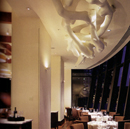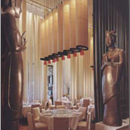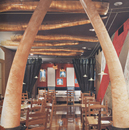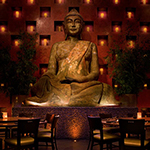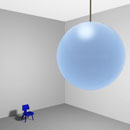
Exaggerate
Exaggerate is a large object or artifact that is over-sized for its interior setting. These figures may be real or artificial, including a full-scale object that is used out of its context and over-scaled for the space, such as a real airplane in a dining space. more
Exaggerate | Restaurant
application
Exaggerate in restaurant design appears frequently as an object-oriented focal point in an entry or a dining area, and in some cases, it becomes a spectacle.
research
Exaggerate was first identified as an archetypical lighting and display practice in art museums where overstatement becomes a component of a visitor’s spatial experience. “Design can be used to visually accentuate size and quality by manipulating proportion and scale, important design elements that also become significant.”1 In retail design the practice introduces an unexpected manipulation of scale or form that contributes to engaging consumers in the retail experience. When exaggeration is used in retail window displays, it is akin to installation art.2 In boutique hotel design the exaggerated elements include furniture in lobby areas and lighting fixtures.3
Exaggerate is a practice used in expensive, as well as vernacular or themed restaurants, and often, it is the exaggerated feature that becomes an icon or a branding device for the restaurant. However, high-end restaurants, such as those published in trade magazines tend to be vast spaces in which the intervention of a massive object is appropriate.
Exaggerate as a restaurant design practice is introduced in trade magazines beginning in the mid-1960s. One early example is the Siamese Starlight Roof restaurant (1964) which featured outsized sculptural objects located between tables, and an abstracted umbrella accentuating a round table capable of seating about ten patrons.
Exaggerate in restaurant design sometimes becomes a spectacle—“an emphasis on an image that dazzles and deceives, seducing or stunning the spectator into submission.”4 Designer Philippe Stark is often credited with designing restaurants as theatrical events where the guest becomes both actor and spectator. The experiential aspect has been described as an “eerie ritual in a décor as stunning as it was subtle.” Stark’s inspiration for the design of the Theatron restaurant in Mexico City, resulted from the building’s former use as Te`atriz (theater). One enters the restaurant via the former stage, whose full height has been preserved. In Outstanding Bar and Restaurant Designs Olivier Boissie`re credits the Theatron design as one in which the “patrons are onstage in a game that the little society of the night is so fond of, that of seeing and being seen, and alternation of voyeurism and exhibitionism. Boissiere continues the metaphor, casting Stark as creating a puppet-theater in which he “pulls the strings from afar” by playing with fantasies and fears of the dark and of the unknown, as well as claustrophobia and agoraphobia.5 Upon entry guests encounter an oversized, framed portrait of a distorted face. This exaggerated feature introduces other bizarre components of the interior experience.
Designers Tony Chi and Jeffrey Beers use exaggerated elements as focal points in restaurants. In Shanghai Lilly (1999) Tony Chi suspended a row of over-scaled pendants from the twenty-foot height ceiling of the main dining area.6 The pendants are translucent, countering the hard materials, wood and marble. The size and location of the pendants draws patrons’ eyes upward in order for them to appreciate the vastness of the interior. Upon entry to the dining area Exaggerate is used again. Large Chinese statuary on marble pedestals acts as columns, framing the view.
A seated Buddha more than two floors in height is the exaggerated element in the TAO restaurant in Las Vegas designed by Studio Gaia and Thomas Schoos Design. In this example, the tables and chairs are organized around the Buddha, and its overwhelming presence makes the tables and chairs appear Lilliputian, no doubt creating a spatial experience for diners.7
Exaggerate as an archetypical practice in restaurant design is object-oriented, achieved in various modes, including a single oversized object placed against a wall or hung from the ceiling. Over-scaled objects are also used in multiples, scattered randomly across the floor, as in the W Hotel in Seoul, Korea. And, in some examples, all of theses techniques are combined.8
end notes
- 1) Joori Suh. “Theory Studies: Contemporary Museum and Exhibition Spaces” (M.A. Thesis, Cornell University, 2003), 54-56; John H. Falk and Lynn D. Dierking, Learing from Museums: Visitor Experiences and the Making of Meaning (New York: Altamira Press, 2000), 126-127.
- 2) Leah M. Scolere, “Theory Studies: Contemporary Retail Design” (M.A Thesis, Cornell University, 2004), 91-95.
- 3) Julie Yang, “Theory Studies: Contemporary Boutique Hotel Designs” (M.A. Thesis, Cornell University, 2005), 54-56.
- 4) Spectacle is defined in Emma Barker, Contemporary Cultures of Display (New Heaven, Conn.: Yale University Press, 1999), 17.
- 5) Olivier Boissie`re, ed., Outstanding Bar and Restaurant Designs (Paris: Telleri, 1998), 7, 45.
- 6) Jie Huang, “A Critique of Contemporary Chinese Restaurants” (M.A. Thesis, Cornell University, 2002), 110-115.
- 7) Debra Scott, “The Tao of Vegas,” Interior Design (April 2006), 269.
- 8) Evidence for the use and the chronological sequence of Exaggerate as a restaurant archetype was developed from the following sources: 1960 Siamese Starlight Roof [1964] William Pahlmann Associates; Hong Kong in "Interior Design at the League," Interior Design 35, no. 6 (June 1964): 112; PhotoCrd: Julius Shulman / 1970 Restaurant in Americana Hotel [1977] Koetter Tharp Cowell & Bartlett; Indianapolis, MN in "Americana in the Midwest," Interior Design 48, no. 11 (Nov. 1977): 149; PhotoCrd: Alexandre Georges; Don Nunzio's [1979] Lambert Woods; San Francisco, CA in Lois Wagner Green, "A Classical Restaurant Mood," Interior Design 50, no. 8 (Aug. 1979): 216; PhotoCrd: Russell MacMasters / 1980 Alo Alo [1985] Adam Tihany; New York, NY in Edie Lee Cohen, "Alo Alo," Interior Design 56, no. 9 (Sep. 1985): 281; PhotoCrd: Peter Paige; Le Triangle [1986] Adam Tihany; Beverly Hills, CA in Susan Colgan, Restaurant Design: Ninety-Five Spaces that Work (New York: Whitney Library of Design, 1987), 16; PhotoCrd: David Glomb; Trattoria dell'Arte [1989] Milton Glaser; New York City in Edie Lee Cohen, "Trattoria dell'Arte," Interior Design 60, no. 6 (Jun. 1989): 215; PhotoCrd: Peter Mauss/Esto / 1990 Theatron Restaurant [1997] Philippe Starck; Mexico City, Mexico in Olivier Boissie`re, ed., Outstanding Bar and Restaurant Designs (Paris: Telleri, 1998), 44; PhotoCrd: N. Ishii/Skinkentiku; Shanghai Lilly [1999] Tony Chi and Associates; Las Vegas, NV in Matteo Vercelloni, New Restaurants in USA 2 (Milano: L'archivolto, 2003) 171; PhotoCrd: Paul Warchol / 2000 Wild Ginger [2000] Haverson Architect and Design; Greenwich, CT in Vercelloni, New Restaurants in USA 2, 203; PhotoCrd: Paul Warchol; Matisse Cafe Restaurant [2000] Milton Glaser; Washington D.C in Melissa Rhodes, "Room with a Hue," Interior Design 71, no. 1 (Jan. 2000): 172; PhotoCrd: Todd Eberle; Restaurant in Park Hyatt [2001] Toni Chi and Associates; Chicago, IL in Jen Renzi, "Home Cooking," Interior Design 72, no. 1 (Jan. 2001): 229; PhotoCrd: Doug Snower; Megu [2004] Yasumichi Morita; New York, NY in Clifford A. Pearson, "Megu," Architectural Record 192, no. 5 (Apr. 2004): 138; PhotoCrd: Nacasa & Partners; Restaurant in W Hotel [2005] Studio Gaia, Tony Chi, Rad; Seoul, Korea in Raul Barreneche, "W Hotel," Architectural Record 193, no. 11 (Nov. 2005):159; PhotoCrd: Seung Hoon Yum; Tao of Vegas [2006] Studio Gaia and Thomas Schoos Design; Las Vegas, NV in Debra Scott, "The Tao of Vegas," Interior Design 77, no. 4 (Apr. 2006): 269; PhotoCrd: Warren Jagger; Nobu 57 [2006] Rockwell Group; New York City in "Fine Dining Restaurant: Nobu 57," Hospitality Design 28, no.5 (July 2006): 106; PhotoCrd: Scott Frances.
bibliographic citations
1) The Interior Archetypes Research and Teaching Project, Cornell University, www.intypes.cornell.edu (accessed month & date, year).
2) Cho, Jasmin. “Theory Studies: Archetypical Practices of Contemporary Restaurant Design.” M.A. Thesis, Cornell University, 2009, 57-64.

